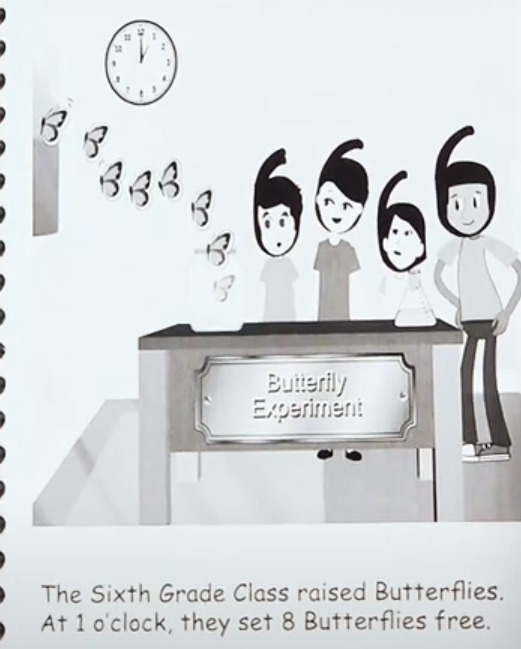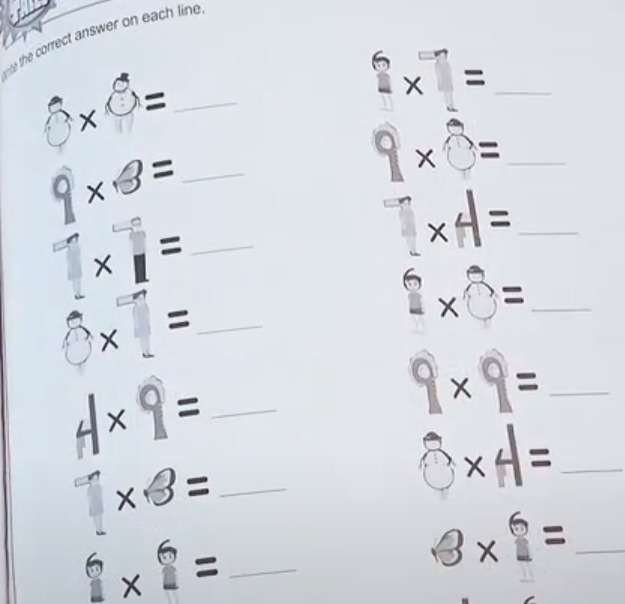
With its easy and memorable illustrated, story-based approach, guided videos and wide-variety of reinforcing activities and exercises, Times Tales can help students learn their multiplication facts without needing a ton of drill.
As a result, it can make math learning a lot less stressful and tear-inducing…for all involved.
What We Like
But watch out for…
What Is Times Tales?
Created by homeschooling moms Jennie Winters and Marilee Flanagan, Times Tales is a multimedia math supplement designed to help kids learn their times tables in a less stressful and more effective manner.
Using visual mnemonics (the association of information with meaningful imagery), the program teaches and helps students remember multiplication facts using stories, videos, various activities, flashcards, quizzes and more.
What Ages Or Grades Is Times Tales Appropriate For?
As the name might imply, Times Tales is aimed at students who are starting or struggling to learn their multiplication tables, i.e. approximately grades 3-5.
The program is broadly split into three levels:
- Times BEFORE the Tales, which teaches lower times tables and prepares students for the main program
- Times Tales, which teaches lower and upper times tables
- Times AFTER the Tales, which is the newest program that teaches 11s and 12s.
As the program is based around math facts, rather than any particular age or grade, Times Tales can be used by students of pretty much any age, such as precocious students who are solid on their addition, skip counting and grouping.
It can, of course, also be an option for older students who are a bit behind in math or who are struggling with their multiplication tables.
That said, while the story-based approach and illustrations can make learning multiplication facts a lot more appealing and memorable for kids, and while mnemonics can work for students of all ages, it may not be the most welcome approach for older students who may not connect with the program’s simple stories and cartoon-like look and feel.
One thing to note is that the program does not teach certain multiplication facts, notably multiplying by 0, 1, 2, 5 and 10, in order to reduce the number of stories that students will have to learn.
As such, parents should probably ensure that their students are secure in these easier and more intuitive multiplication facts before tackling the more complex ones the program focuses on.
What Learning Material Does Time Tales Offer?
Time Tales is offered as a paper-based book and workbook program, as well as a video-based one.
Both the video-based and paper-based formats are more or less self-contained and parents are free to choose both (using the materials as they would like), or choose one or the other.
Times Tales Story Book and Workbook
Times Tales Storybooks
Times Tales Storybooks are spiral bound, black and white, non-consumable softcover books that contain little stories and characters that are used to introduce multiplication facts.
For example, six is turned into a class of sixth graders whose heads resemble the number.
Each fact (6×4, for example) is given a little story and related illustration to help kids remember the product.
Although the books don’t contain the most sophisticated artwork or complex stories we’ve ever seen, and while the black and white format isn’t exactly the most eye catching, by and large the illustrations are cute and memorable and the stories are quite short and easy to remember in order, which is really key to turning them into an effective mnemonic.

As a result, we feel that even younger kids should be able to read through the books and recall the stories correctly with a little practice.
Workbooks
In addition to the storybook Times Tales also includes a consumable softcover workbook, which serves to reinforce the mnemonics introduced through the stories.
To do so the workbooks contain things like reviews of characters, exercises, story questions, fill in the blanks, puzzles, cut out flashcards and cubes, quizzes and more.

The workbooks themselves are illustrated and contain simple and easy to read instructions, questions and exercises.
The work pages themselves are short, not that overwhelming and contain a lot of different types of non-drill activities, which should go a long way in making them a lot less intimidating to students, particularly those who are a bit intimidated by math.
On the downside, while they do have some fun illustrations, they aren’t the most exciting to look at, adopting the same black and white style of the storybooks.
Times Tales Videos
In addition to its paper-based learning materials, Times Tales also includes a video-based learning component, which can be used alongside or instead of the story and workbooks.
The videos are animated and are full color, which is in contrast with the paper-based material, and serve to bring the program’s cartoon characters to life.
Lessons are narrated by an animated teacher who introduces concepts, reads the stories aloud and pops up on screen now and again to guide students along through the lesson components.
An example of a lesson can be seen in the sample video below.
In general, the videos are pretty comprehensive and serve to introduce the program’s characters, the stories, follow things up with periodic quizzes on multiplication facts and story components, and reinforce learning by doing on-screen flashcard work and division problems.
Overall, the Times Tales videos aren’t the most sophisticated animations we’ve ever seen, feeling much more like a story book brought to life than a full cartoon, and they probably won’t be able to compete with the latest TV shows, video games or internet clips.

That said, they do carry students through Times Tales pretty well and allow students to do a lot of work on their own, something that busier parents, new homeschoolers and those who are uncertain of their math skills should take notice of.
The videos also use a lot of simple language, visual demonstrations and read alouds, which make them an excellent resource for dyslexic students and those with reading difficulties, allowing them to avoid getting bogged down by the reading component of the program’s workbooks and storybooks.
Finally, and interestingly, the videos are also available as DVDs, streaming and USB, which gives homeschools a good bit more flexibility in terms of how they can use them than is usually seen in these kinds of programs.
By having both online and offline videos available, Times Tales can be used effectively by students who live in areas where the internet is a bit spotty or slow, as well as by parents who don’t feel comfortable leaving their kids on an internet-enabled device alone.
Times Tales Approach To Teaching
Visual & Story-based Mnemonics
Times Tales uses visual mnemonics to help students learn multiplication facts.
Mnemonic devices are, essentially, little tricks to help individuals remember key facts and other information without having to do lots of repetition and drill.
They can involve linking information to keworks, pegwords or rhymes, for example helping students remember the process of long division as Dad Mom Sister Brother and Rover (Divide, multiply, subtract, bring down and remainder).
With Times Tales, the program uses illustrated stories as a kind of word association.
To teach a multiplication fact (6×4=24, for example), students are given short phrases or sentences and a picture with highly identifiable and memorable characters representing numbers doing something of note.

The story, being cute or amusing, serves to create an association between the numbers shown and their product.
If a student remembers the order of the story and the characters involved, then they will remember the underlying fact.
Overall, the use of mnemonics can be a very effective way of helping students remember math facts, particularly for those who struggle with rote memorization and drill, those who have some kind of math phobia and those who learn best either visually or through listening.
One thing that parents should be aware of, however, is that the use of mnemonics (such as in the Times Tales stories) can seem like something of an extra step to students who are good at memorizing math facts.
Similarly, because they need to be remembered in order, math mnemonics can seem a bit picky at times to young students.
Activity-based reinforcement
Times Tales isn’t a program that just has students memorize a story and move on, it actually includes a good deal of related activities that help reinforce the story-based approach and make sure students keep the order straight in their heads.
The workbooks and videos offer students a good deal of periodic review, are fairly thorough, with students periodically being quizzed or asked to review key characters, the story order, key ideas and so on.
This use of activities addresses the issue of order that we mentioned in the previous section, helping students keep each story in the right order, which in turn helps keep the underlying multiplication fact correct.
There is also a good deal of variety in terms of exercises, with students being offered fill in the blanks, crosswords, flashcard work and more, which can keep things from getting a little too boring even if they are working on a single, fairly simple story.

That said, it should be noted that there aren’t a lot of hands-on learning activities with Times Tales, which can be a bit disappointing to students who enjoy tactile or kinesthetic learning.
It is, ultimately, a fairly visual and auditory program and there are, for example, no arts or crafts related exercises or activities that would take the learning out of the books or away from the screen for very long and allow students to get hands-on with the stories and learning.
Not Just Multiplication
Finally, Times Tales goes a bit beyond multiplication and includes “Expert Level” exercises, which touch on division facts.
These are used to reinforce a student’s understanding of multiplication facts by having students use division to break a fact apart and generally approach them from different angles.

For example, a student might be presented with 24/6 and have to find the quotient of 4, which reinforces that 4×6=24.
The inclusion of division is kind of interesting and can challenge students to stretch their understanding of a math fact, which is something we appreciate.
As the instruction of the program is mainly focused on the multiplication table, however, it does mean that some parents may need to introduce the concept of division first before tackling these sections.
How It Works
Times Tales is a pretty simple math supplement to use.
The program is divided into two parts, part 1 covers lower multiplication facts (3 and 4) while part 2 covers upper math facts (6, 7,8,9), making a total of 18 stories for students to learn.
| Part 1 | Part 2 |
| 3×6 | 6×6 |
| 3×7 | 6×7 |
| 3×8 | 6×8 |
| 3×9 | 6×9 |
| 4×6 | 7×7 |
| 4×7 | 7×8 |
| 4×8 | 7×9 |
| 4×9 | 8×8 |
| 8×9 | |
| 9×9 |
Each lesson covers one of these multiplication facts, and when parents complete a part of the program (lower or upper) they are advised to take about a week or so to reinforce the learning through the program’s exercises.
Times Tales can be approached in one of three ways, either using the storybook and workbook, using the video, or some combination of the two.
Lessons in the program follow a six step approach, which are slightly different depending on whether parents go for the video or paper-based method.
6 step paper-based lessons
At the beginning of the paper-based lesson, students are first introduced to a number character (3 is a butterfly, 4 is a chair, 6 is a class, and so on).
Students then learn the story, which uses a combination of a simple story and memorable illustration containing two of these characters to convey a math fact.
The lesson then moves on to a review, which is located in the workbook, where parents make sure that students have understood the story correctly using activities such as letter jumbles, fill in the blanks and more.
The program then introduces some additional review, which is intended to reinforce the story in the student’s mind, and involves a few more in-depth exercises, such as review questions, crossword puzzles and quizzes.

Following this, the workbooks include a particular section called a lightbulb moment, which explicitly lays out and explains to the student the connection between the story they’ve learned and the multiplication fact, clarifying the ultimate purpose of the lesson.
Finally, parents and students move on to an assessment section of sorts, where students practice flashcards, are assigned quizzes and may even do some division work around the multiplication fact.
6 step video-based lessons
The video lessons follow a slightly different 6 step structure, designed as they are for more of a self-study approach.
Like the paper-based format, students first learn and review the characters of Times Tales.
They then move on to the story component, which is animated and read aloud by the narrator.
Once the story is complete, the narrator will appear on screen and offer a short game show-like quiz, which assesses a student’s retention of information by asking them specific questions about the story and order.

Once a student gets these questions correct, they then retell the story in their own words to their parents in the correct order, ensuring that the mnemonic they have learned has been encoded correctly.
If they can do this correctly, the video will then move on to doing a review and reinforcement exercise using on-screen flashcards.
These begin with the numbers represented first as characters and then as actual numbers in equation form.
Our Thoughts on Times Tales
Overall, we feel that Times Tales mnemonic lessons and approach to teaching multiplication facts can be very effective and a good alternative to rote drilling the multiplication table.
Its use of short stories and visually distinctive number characters make the math facts very easy to remember, even over time.
The program also manages to avoid many of the pitfalls of mnemonic math learning by keeping things short and memorable and offering students lots of focused practice and review to ensure they encoded everything in the correct order and sequence.
In fact, the program offers a lot of reinforcement in general.
With a wide variety of quizzes, puzzles, flashcards, review questions and more, the lessons really manage to help students retain these critical multiplication facts without a lot of repetitive multiplication table drills.
As a result, we feel that Times Tales lessons can be a lot less stressful and more incremental than other methods.
Additionally, we particularly liked how the flashcard practice and quizzes slowly brings real numbers and symbols into the mix.
Practice usually starts with numbers presented as the characters, bringing them to mind and reinforcing the learning.

swapping the number characters for the equation forms they will be working with in their school work.

This incremental method can help students get a better grasp of these abstract number relationships and an approach that reminded us of the Singapore method’s CPA approach, which is found in a number of highly effective conceptual math programs, such as Singapore Math or Math in Focus.
In a similar vein, we also liked the workbook’s lightbulb moments, where Times Tales explicitly and directly draws a connection between its stories and the underlying math facts.
Finally, we liked the flexibility that the program offers through its paper- and video-based options.
Times Tales gives parents the option of working with multimedia or screen-based lessons, which also allow for greater self-study, or with traditional, paper-based lessons, which can provide greater parent-student interaction and less screen time.
On the downside, we felt that Times Tales animations and illustrations are a bit basic (particularly the black and white ones in the books) and they may not be as enthralling to students as other options that can be found online.
Parents should also be aware that Times Tales does not cover all multiplication facts, notably not covering 0,1,2,5 or 10 (although the new BEYOND the Tales books do cover 11 and 12).
While these are simpler multiplication facts to learn and while this reduces the overall number of stories that students have to remember, it does mean that parents will have to figure out a way to teach these to their students themselves.
How Easy is Times Tales To Teach?
Overall, we found that Times Tales is quite easy to teach.
Its video-based lessons effectively carry students through its learning, review and assessment components and really reduce the amount of work that a parent has to do when it comes to teaching the multiplication table.
At the same time, while the workbooks aren’t quite as self-study as the videos, they do provide an ample amount of explanations and instructions so as to make them effectively open and go.
The only thing parents need to really be careful with in this program is to take the memory and story review seriously and have students do all the required exercises so that students have the best chance at recalling the stories as completely as possible.
Pros and Cons
Pros
Fun, non-drill way of learning multiplication tables
Times Tales uses a combination of illustrated characters, easy to remember stories and a variety of reinforcing activities to teach the multiplication table.
This can often be a lot less stressful, and often more enduring, for students and parents compared to the usual rote memorization and drill-based approaches.
Lots of varied exercises
Offering students game-show quizzes, puzzles, jumbles, review questions and more, there are a lot of different kinds of review activities in the Times Tales workbooks and printables, which can make going through lessons a lot less boring.
Strong review component
Times Tales is a mnemonic approach to learning the multiplication table and it offers students a lot of opportunity to practice and review its stories in the right order, something that is critical to the approach and something that other such programs fall short of.
Easy to use, open and go
Times Tales’ workbooks are very well laid-out and sequential, with easy to read and clear instructions throughout.
As a result, parents (and students) don’t really have to do much in the way of prep before lessons and can simply open the materials up and start learning.
Offered in both video and paper-based formats
Times Tales offers parents a good amount of flexibility when it comes to how they want to teach the program.
There is a video-based program, a digital option that is good for more independent learning, and a paper-based program, which might be better suited to those who want to reduce screen time or have a more traditional experience.
Parents can, of course, choose to use both (or a mix of the two), which makes it a pretty flexible program.
Videos available offline and online
We liked the fact that, unlike some other homeschool programs out there, Times Tales offers its video courses on DVD, USB and streaming.
This allows it to be more effectively used by those in areas with poor internet service and provides more options for parents who don’t feel comfortable leaving their student alone with an internet-enabled device.
Can encourage self-study or be parent-led
With its workbook-based and video-based options, Times Tales offers parents more ways of teaching their students.
Those who enjoy a more parent-led approach can go through the program using its books and workbooks, while busier homeschools can pursue a more self-study option through the heavily guided and structured Times Tales videos.
Cons
Doesn’t teach all multiplication facts
Times Tales only includes 3,4,6,7,8 and 9 multiplication facts (and 11 and 12 in the BEYOND the Tales series).
While this reduces the amount of stories students have to learn, it also means that parents will have to handle 0, 1,2,5 and 10 on their own.
Not the most visually stunning
While they are cute and are certainly memorable, Times Tales’ illustrations and animations aren’t the most sophisticated out there and may not greatly impress kids raised on more cutting edge media and content.
Who Is Times Tales Ideal For?
Students who have struggled with memorizing the times tables
For a diversity of reasons, many students struggle with memorizing the multiplication table, which can have an effect on their math skills down the line.
Times Tales’ visual mnemonic-based approach can make things a little easier, providing an alternative to simple rote memorization that can help things finally click for these students.
Students who hate rote work and drill
Some students also hate the rote memorization and drill that comes with learning their times tables.
With its stories and various workbook activities, Times Tales can offer an alternative to traditional drill that can make learning multiplication more approachable and practice more appealing.
Busy parents looking for a more self-study approach to teaching multiplication facts
Times Tales video-based option can let students do much of the learning and practice on their own, which can free busy parents up a little more to take care of the plethora of other homeschool and life tasks that are on their schedule.
Visual and auditory learners
With its illustrated stories and narrated videos, Times Tales can be a great option for those who prefer to learn with visual or auditory material.
Who Is It Not Ideal For?
Students who do well with rote memorization in math
Although many students will enjoy the story-based approach that Times Tales uses, some students do quite well with rote memorization and drill and may find program’s methods a bit slower.
Those looking for a complete math program
Although it does touch on some division work, Times Tales is a supplement with a focused goal – helping students more effectively learn their multiplication facts.
As a result, it won’t really suit those looking for a complete math program.
Price
Note: Prices correct as of writing. All prices in USD.
As we’ve discussed, Times Tales is offered in print format, which consists of a storybook and workbook, as well as a video-based course (with printable activities).
Parents can buy a Times Tales deluxe set, which contains all of the above materials, for around $49.95.
They can also purchase the materials individually if they so choose.
Times Tales Storybook $9.95
Times Tales Workbook – $17.95
Times Tales Video Course – $24.95
As always parents should check for the latest prices, as well as for any offers or specials that may be on offer.
Or
Or
Is It Worth The Price?
Overall, we consider Times Tales to be an interesting math supplement that can provide a lot of value to homeschooling families.
The program’s illustrated and story-based mnemonic approach to teaching, can be a highly effective way of learning multiplication, providing an alternative to rote memorization that can quickly help it all “click” for students.
The program also offers a good deal of engaging review activities that go beyond endless drilling, letting students solidify their knowledge of their times tables through puzzles, game show questions, word jumbles, game cubes and more.
Finally, it is a very flexible and adaptable program, allowing parents to choose whether to use it as a digital, video-based self-study program, a traditional parent-led pen and paper approach, or a mix of both.
Bottom Line
Memorizing the multiplication table is an often dreaded part of teaching early elementary math.
With its easy and memorable illustrated, story-based approach, guided videos and wide-variety of reinforcing activities and exercises, Times Tales can help students learn their multiplication facts without needing a ton of drill.
As a result, it can make math learning a lot less stressful and tear-inducing…for all involved.

About the Author
David Belenky is a freelance writer, former science and math tutor and a tech enthusiast. When he’s not writing about educational tech, he likes to chill out with his family and dog at home.
